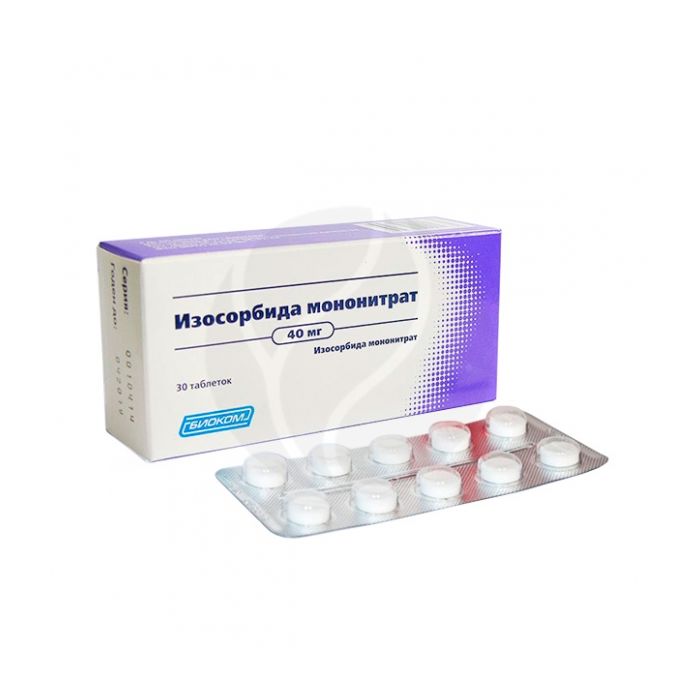Isosorbide mononitrate tablets 40mg, No. 30
Expiration Date: 05/2027
Russian Pharmacy name:
Изосорбида мононитрат таблетки 40мг, №30
Prevention of angina attacks. Chronic heart failure (as part of combination therapy), some forms of pulmonary hypertension and cor pulmonale (as part of combination therapy).
Set individually. A single dose of 10-100 mg, depending on the dosage form used. The frequency of admission and the duration of treatment depend on the indications and the effectiveness of the therapy.
Tablets white or white with a grayish tinge
Active substance:
isosorbide mononitrate
Acute circulatory disorders (shock, vascular collapse); cardiogenic shock in cases where high end diastolic pressure in the left ventricle is not provided by using intra-aortic counterpulsation or by administering drugs that have a positive inotropic effect; severe arterial hypotension (systolic blood pressure less than 90 mm Hg, diastolic - less than 60 mm Hg); concomitant use of sildenafil (PDE inhibitor); hypersensitivity to nitrates.
pharmachologic effect
Peripheral vasodilator with a predominant effect on venous vessels, antianginal agent. It causes a decrease in myocardial oxygen demand due to a decrease in preload (expansion of peripheral veins and a decrease in blood flow to the right atrium) and afterload (decrease in systemic vascular resistance), and also has a direct coronary dilating effect. Promotes redistribution of coronary blood flow in areas with reduced blood supply. Increases exercise tolerance in patients with coronary artery disease, angina pectoris. In heart failure, it helps unload the myocardium by reducing preload. Reduces pressure in the pulmonary circulation. Pharmacokinetics After oral administration, isosorbide-5-mononitrate is rapidly and completely absorbed from the gastrointestinal tract. Bioavailability is 90-100%.Plasma concentration is directly proportional to dose.
Isosorbide-5-mononitrate is almost completely biotransformed in the liver with the formation of inactive metabolites.
It is excreted by the kidneys mainly in the form of metabolites, 2% - unchanged. T1 / 2 is 4-5 hours.
Indications of the active substances of the drug
Prevention of angina attacks. Chronic heart failure (as part of combination therapy), some forms of pulmonary hypertension and cor pulmonale (as part of combination therapy).
Dosage regimen
Set individually. A single dose of 10-100 mg, depending on the dosage form used. The frequency of admission and the duration of treatment depend on the indications and the effectiveness of the therapy.
Side effect
From the side of the cardiovascular system: at the beginning of treatment - 'nitrate' headache (usually disappears after a few days with continued treatment); possible arterial hypotension, dizziness, tachycardia, weakness; rarely with severe arterial hypotension - increased symptoms of angina pectoris (paradoxical effect of nitrates); in some cases - collapse, bradyarrhythmia, syncope.
From the digestive system: rarely - nausea, vomiting.
Dermatological reactions: transient redness of the skin; in some cases - exfoliative dermatitis.
Allergic reactions: skin manifestations.
Others: in some cases - a decrease in the speed of psychomotor reactions.
Contraindications for use
Acute circulatory disorders (shock, vascular collapse); cardiogenic shock in cases where high end diastolic pressure in the left ventricle is not provided by using intra-aortic counterpulsation or by administering drugs that have a positive inotropic effect; severe arterial hypotension (systolic blood pressure less than 90 mm Hg, diastolic - less than 60 mm Hg); concomitant use of sildenafil (PDE inhibitor); hypersensitivity to nitrates.
Application during pregnancy and lactation
Application during pregnancy and lactation (breastfeeding) is possible in cases where the expected benefit of therapy for the mother outweighs the potential risk to the fetus or child.
special instructions
Not used to relieve angina attacks. Use with caution with increased intracranial pressure.
Influence on the ability to drive vehicles and use mechanisms
During the period of treatment, it is not recommended to drive vehicles and engage in other potentially hazardous activities that require quick psychomotor reactions.
Drug interaction With simultaneous use with adsorbents, astringents and coating agents, the absorption of isosorbide mononitrate decreases.
With simultaneous use with anticholinergics, memory and attention impairment in elderly patients is possible.
With the simultaneous use of vasodilators, calcium channel blockers, tricyclic antidepressants, ethanol, an increase in the hypotensive effect is possible.
With simultaneous use with antihypertensive drugs, beta-blockers, antipsychotics, PDE inhibitors, an increase in the hypotensive effect is possible.
With simultaneous use with dihydroergotamine, it is possible to increase the concentration and enhance the effect of dihydroergotamine.
With simultaneous use with norepinephrine, the therapeutic effect of norepinephrine decreases.
With simultaneous use with sildenafil, there is a risk of severe arterial hypotension and myocardial infarction.

